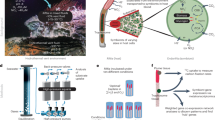Abstract
Two main pathways of carbon dioxide fixation have been demonstrated in marine invertebrates, the carboxy-lation of propionate to form succinate in the oyster1, and the carboxylation of pyruvate to form malate in flat-worms2. The presence of enzyme systems capable of using carbon dioxide for synthetic purposes has been established in representatives of 14 phyla of animals3, and many micro-organisms4. Evidence continues to accumulate in support of the idea of Krebs5 that carbon dioxide is an essential compound in the metabolism of all cells. It has been stated often that if the citric acid cycle is to provide intermediates for biosynthetic reactions, fixation is necessary to replenish the supply of acids.
Similar content being viewed by others
References
Hammen, C. S., and Wilbur, K. M., J. Biol. Chem., 234, 1268 (1959).
Hammen, C. S., and Lum, Susan C., J. Biol. Chem., 237, 2419 (1962).
Hammen, C. S., and Osborne, P. J., Science, 130, 1409 (1959).
Quayle, J. R., Ann. Rev. Microbiol., 15, 119 (1961).
Krebs, H. A., Nature, 147, 560 (1941).
Bishop, D. W., in Comparative Animal Physiology, 275 (Saunders, Philadelphia, 1950).
Umbreit, W. W., Burris, R. H., and Stauffer, J. F., Manometric Techniques (Burgess, Minneapolis, 1957).
Harvey, H. W., The Chemistry and Fertility of Sea Waters, second ed. (Camb. Univ. Press, Cambridge, 1957).
Conway, E. J., Microdiffusion Analysis and Volumetric Error, fourth ed. (Crosby Lockwood, London, 1957).
Fairbairn, D., Exp. Parasitol., 3, 52 (1954).
Glocklin, Vera C., and Fairbairn, D., J. Cell. Comp. Physiol., 39, 341 (1952).
Landau, B. R., Ashmore, J., Hastings, A. B., and Zottu, Sylvia, J. Biol. Chem., 235, 1856 (1960).
Spector, W. S., (edit.), Handbook of Biological Data (Saunders, Philadelphia, 1956).
Bernelli-Zazzera, A., and Bassi, M., Giorn. Biochem., 4, 356 (1955).
Wennig, F., and Schmör, J., Medizinische Welt, 251 (1959).
Strauss, B. S., J. Biol. Chem., 225, 535 (1957).
Fuller, R. C., Science, 124, 1253 (1956).
Heplar, J. Q., and Tatum, E. L., J. Biol. Chem., 208, 489 (1954).
Author information
Authors and Affiliations
Rights and permissions
About this article
Cite this article
HAMMEN, C., LUM, S. Carbon Dioxide Fixation in Marine Invertebrates: Quantitative Relations. Nature 201, 416–417 (1964). https://doi.org/10.1038/201416a0
Issue Date:
DOI: https://doi.org/10.1038/201416a0
- Springer Nature Limited





